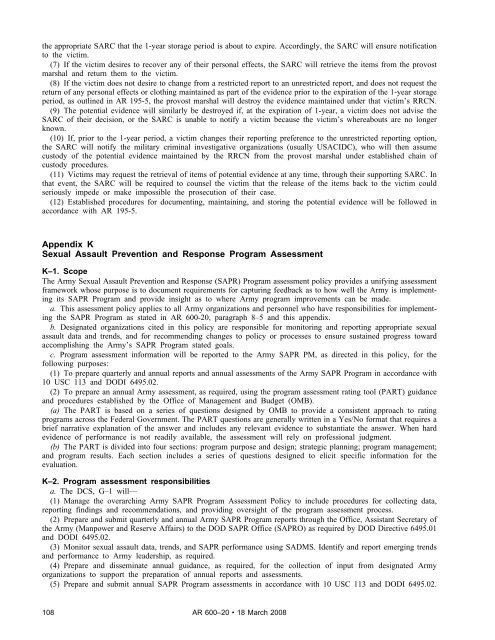AR 600-20, Army Command Policy - Army Publishing Directorate ...
AR 600-20, Army Command Policy - Army Publishing Directorate ...
AR 600-20, Army Command Policy - Army Publishing Directorate ...
You also want an ePaper? Increase the reach of your titles
YUMPU automatically turns print PDFs into web optimized ePapers that Google loves.
the appropriate S<strong>AR</strong>C that the 1-year storage period is about to expire. Accordingly, the S<strong>AR</strong>C will ensure notification<br />
to the victim.<br />
(7) If the victim desires to recover any of their personal effects, the S<strong>AR</strong>C will retrieve the items from the provost<br />
marshal and return them to the victim.<br />
(8) If the victim does not desire to change from a restricted report to an unrestricted report, and does not request the<br />
return of any personal effects or clothing maintained as part of the evidence prior to the expiration of the 1-year storage<br />
period, as outlined in <strong>AR</strong> 195-5, the provost marshal will destroy the evidence maintained under that victim’s RRCN.<br />
(9) The potential evidence will similarly be destroyed if, at the expiration of 1-year, a victim does not advise the<br />
S<strong>AR</strong>C of their decision, or the S<strong>AR</strong>C is unable to notify a victim because the victim’s whereabouts are no longer<br />
known.<br />
(10) If, prior to the 1-year period, a victim changes their reporting preference to the unrestricted reporting option,<br />
the S<strong>AR</strong>C will notify the military criminal investigative organizations (usually USACIDC), who will then assume<br />
custody of the potential evidence maintained by the RRCN from the provost marshal under established chain of<br />
custody procedures.<br />
(11) Victims may request the retrieval of items of potential evidence at any time, through their supporting S<strong>AR</strong>C. In<br />
that event, the S<strong>AR</strong>C will be required to counsel the victim that the release of the items back to the victim could<br />
seriously impede or make impossible the prosecution of their case.<br />
(12) Established procedures for documenting, maintaining, and storing the potential evidence will be followed in<br />
accordance with <strong>AR</strong> 195-5.<br />
Appendix K<br />
Sexual Assault Prevention and Response Program Assessment<br />
K–1. Scope<br />
The <strong>Army</strong> Sexual Assault Prevention and Response (SAPR) Program assessment policy provides a unifying assessment<br />
framework whose purpose is to document requirements for capturing feedback as to how well the <strong>Army</strong> is implementing<br />
its SAPR Program and provide insight as to where <strong>Army</strong> program improvements can be made.<br />
a. This assessment policy applies to all <strong>Army</strong> organizations and personnel who have responsibilities for implementing<br />
the SAPR Program as stated in <strong>AR</strong> <strong>600</strong>-<strong>20</strong>, paragraph 8–5 and this appendix.<br />
b. Designated organizations cited in this policy are responsible for monitoring and reporting appropriate sexual<br />
assault data and trends, and for recommending changes to policy or processes to ensure sustained progress toward<br />
accomplishing the <strong>Army</strong>’s SAPR Program stated goals.<br />
c. Program assessment information will be reported to the <strong>Army</strong> SAPR PM, as directed in this policy, for the<br />
following purposes:<br />
(1) To prepare quarterly and annual reports and annual assessments of the <strong>Army</strong> SAPR Program in accordance with<br />
10 USC 113 and DODI 6495.02.<br />
(2) To prepare an annual <strong>Army</strong> assessment, as required, using the program assessment rating tool (P<strong>AR</strong>T) guidance<br />
and procedures established by the Office of Management and Budget (OMB).<br />
(a) The P<strong>AR</strong>T is based on a series of questions designed by OMB to provide a consistent approach to rating<br />
programs across the Federal Government. The P<strong>AR</strong>T questions are generally written in a Yes/No format that requires a<br />
brief narrative explanation of the answer and includes any relevant evidence to substantiate the answer. When hard<br />
evidence of performance is not readily available, the assessment will rely on professional judgment.<br />
(b) The P<strong>AR</strong>T is divided into four sections: program purpose and design; strategic planning; program management;<br />
and program results. Each section includes a series of questions designed to elicit specific information for the<br />
evaluation.<br />
K–2. Program assessment responsibilities<br />
a. The DCS, G–1 will—<br />
(1) Manage the overarching <strong>Army</strong> SAPR Program Assessment <strong>Policy</strong> to include procedures for collecting data,<br />
reporting findings and recommendations, and providing oversight of the program assessment process.<br />
(2) Prepare and submit quarterly and annual <strong>Army</strong> SAPR Program reports through the Office, Assistant Secretary of<br />
the <strong>Army</strong> (Manpower and Reserve Affairs) to the DOD SAPR Office (SAPRO) as required by DOD Directive 6495.01<br />
and DODI 6495.02.<br />
(3) Monitor sexual assault data, trends, and SAPR performance using SADMS. Identify and report emerging trends<br />
and performance to <strong>Army</strong> leadership, as required.<br />
(4) Prepare and disseminate annual guidance, as required, for the collection of input from designated <strong>Army</strong><br />
organizations to support the preparation of annual reports and assessments.<br />
(5) Prepare and submit annual SAPR Program assessments in accordance with 10 USC 113 and DODI 6495.02.<br />
108 <strong>AR</strong> <strong>600</strong>–<strong>20</strong> 18 March <strong>20</strong>08
















